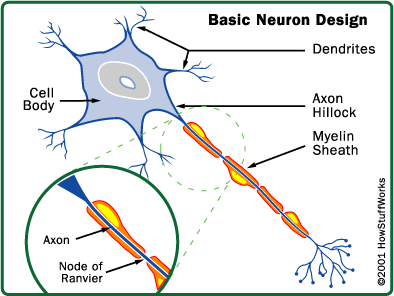Unit 5: Neuroscience
|
The Neuron Soma (cell body): Contains nucleus and support systems Dendrites: Tree-like branches that receive information from other neurons Axon: Long fiber that passes info to other neurons Myelin: Fatty substance on some axons--speeds up neural transmissions Terminal Branches of Axon: Form junctions with other cells and contain synaptic vesicles Synaptic vesicles: sac-like structures that contain neurotransmitters Synapse: The tiny gap between the sending and receiving neurons Neural Networks: Clusters of neurons that work together and become strengthened with use.
Neural Communication: Neurons communicate
via an electrochemical process |
Chemical Process 1. When the action potential reaches the terminal buttons on the ends of the terminal branches, it causes the synaptic vesicles to release neurotransmitters into the synapse. 2. The neurotransmitters then bind to receptor sites on the receiving neuron (like a key fitting into a lock). Some neurotransmitters are excitatory (create a new action potential) while others are inhibitory. 3. After neurotransmitters have done their job, they may be destroyed by other chemicals released into the synapse. Or, reuptake may occur. Reuptake: Neurotransmitters are reabsorbed by the sending neuron and recycled for future use. Neurotransmitters Acetylcholine (Ach): Muscle movement, learning, and memory. An undersupply is involved in Alzheimer's disease. Dopamine: Involved in learning, attention, and emotion. An Excess dopamine is involved in schizophrenia. Serotonin: Affects mood, hunger, sleep, and arousal. An undersupply is linked to depression. Norepinephrine: Helps control alertness and arousal. An undersupply can lead to depression. An oversupply can lead to manic symptoms. GABA (gamma-aminobutytic acid): Major inhibitory neurotransmitter. An undersupply can lead to tremors, seizures, and insomnia. Glutamate: Major excitatory neurotransmitter; involved in memory. Oversupply can overstimulate the brain leading to migraines (this is why some people avoid MSG in food). Endorphins: natural opiate-like neurotransmitter linked to pain control and pleasure. Drugs and Neurotransmitters Agonists: Drugs that are so similar to a neurotransmitter that they can mimic its effects-or-they may block reuptake of a neurotransmitter. Antagonists: Drugs that inhibit a neurotransmitters release-or-they may occupy the receptor site on the receiving neuron, thus blocking the neurotransmitter form binding. Go to Page 2 |
